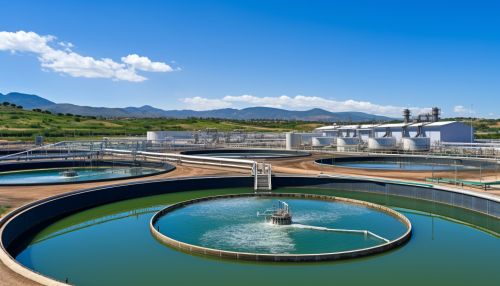Industrial discharge
Overview
Industrial discharge refers to the release of waste materials, often in the form of water or gas, from industrial activities into the environment. This waste, which can contain a variety of pollutants, is typically discharged into bodies of water, the atmosphere, or onto land. Industrial discharge is a significant source of environmental pollution and is subject to regulation and control in many countries.
Types of Industrial Discharge
Industrial discharge can be classified into several types, based on the nature of the waste and the industry from which it originates.
Liquid Waste
Liquid waste is the most common form of industrial discharge. It includes wastewater from manufacturing processes, cooling water, and stormwater runoff. Industries such as food processing, chemical manufacturing, and metalworking are significant sources of liquid waste. This waste can contain a variety of pollutants, including organic compounds, heavy metals, and suspended solids.


Solid Waste
Solid waste is another form of industrial discharge. It includes sludge from wastewater treatment, scrap metal, and other by-products of manufacturing processes. Solid waste is typically disposed of in landfills, although some types of solid waste can be recycled or used as a source of energy.
Gaseous Waste
Gaseous waste, or air emissions, are released into the atmosphere from industrial processes. These emissions can include greenhouse gases, such as carbon dioxide and methane, as well as other pollutants, such as sulfur dioxide and nitrogen oxides. Industries such as power generation, oil refining, and chemical manufacturing are significant sources of gaseous waste.
Environmental Impact
The environmental impact of industrial discharge is significant and varied. It can lead to water pollution, air pollution, soil contamination, and harm to wildlife.
Water Pollution
When industrial discharge is released into bodies of water, it can lead to water pollution. This can harm aquatic life and make the water unsafe for human use. Some pollutants, such as heavy metals, can accumulate in the environment and pose long-term risks.
Air Pollution
Gaseous waste from industrial processes can contribute to air pollution. This can harm human health, contribute to climate change, and cause damage to buildings and other structures.
Soil Contamination
Solid waste from industrial processes can lead to soil contamination. This can harm plants and wildlife, make the land unsuitable for agriculture, and pose risks to human health.
Harm to Wildlife
Industrial discharge can harm wildlife, both directly and indirectly. Aquatic life can be harmed by water pollution, while air pollution can harm birds and other animals. Soil contamination can harm plants and the animals that rely on them for food.
Regulation and Control
Industrial discharge is subject to regulation and control in many countries. These regulations aim to limit the amount of waste that can be discharged and require industries to treat their waste before it is released into the environment.
Waste Treatment
Many industries treat their waste before it is discharged. This can involve physical processes, such as filtration or sedimentation, chemical processes, such as neutralization or oxidation, or biological processes, such as aerobic or anaerobic digestion.
Waste Minimization
Waste minimization involves reducing the amount of waste produced by an industry. This can be achieved through process optimization, recycling, and the use of cleaner technologies.
Monitoring and Enforcement
Regulatory agencies monitor industrial discharge to ensure compliance with regulations. This can involve regular inspections, testing of waste samples, and review of waste management plans. Non-compliance can result in fines, penalties, and other enforcement actions.
